Is It Time To Revisit Hypnotizing Bigfoot Witnesses?
Posted by: Loren Coleman on May 13th, 2012
Loren Coleman ©2012
Is the above the right first question to ask? Should we start there before speculating further in so many avenues? Has hominology truly realized the fluid nature of what we are dealing with, as has been explored in a parallel field, ufology?
Back in 2006, I discussed “The Evolution of Cryptozoology Drawings.” I found that initial eyewitnesses’ attempts to capture what they saw did change through the artwork created by later illustrators, some with their own agendas, and sometimes through the retellings of the witnesses. I spoke on this issue at the original Texas Bigfoot group’s early 2005 conference and at the Bates College’s cryptozoology symposium held in October 2005 in Lewiston, Maine.
It may be appropriate now to look at another issue in a related realm. First, two questions: What if eyewitnesses who are describing Bigfoot are not actually seeing what they think they are? Do we know what happens in a Sasquatch encounter is correctly be referenced for us via the human eyewitnesses?
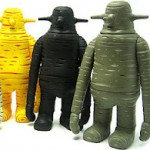
The example of the Pascagoula Critters, which, by definition, are part of ufology might not seem like a good place to start talking about the eyewitness testimony of Bigfoot witnesses. But there are lessons to be learned here, and perhaps it is time for Sasquatch investigators to look for some comparable data to inform our cryptid pursuits. Physical evidence is important, but then so too is the tricky world of firsthand encounter (eyewitness) sighting data, as well.
Regarding the Pascagoula case, University of California professor James Harder investigated the story, as did Dr. J. Allen Hynek, who represented the U.S. Air Force. Harder and Hynek worked together on the case. First they interviewed the two fishermen eyewitnesses, Calvin Parker, 19, and Charles Hickson, 42, together. Harder tried to do regressive hypnosis on Hickson, but the alleged abductee was so frightened that the hypnosis was stopped. Both of the witnesses, however, took polygraph tests, and both passed without a problem. Harder and Hynek both believed that the two tormented men were telling the truth.
What occurred with the depiction of the Pascagoula entities leads to similar insights as what I described in “The Evolution of Cryptozoology Drawings” for the changing view of Momo (the Missouri Monster). For the Pascagoula experience, from the supposedly “based on the eyewitness” drawings to their morphing into popular cultural comic books, shiny figurines, and one-of-a-kind art, the evolution of these “critters” is somewhat predictable.
From the Air Force’s investigations’ images…
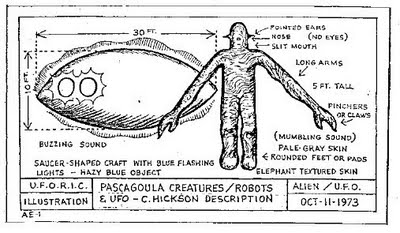
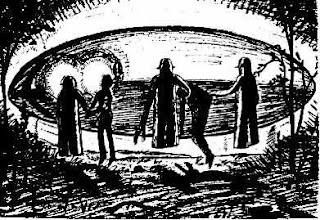
…to the following comic book graphic of the event which certainly does demonstrate that some leaps are big ones.
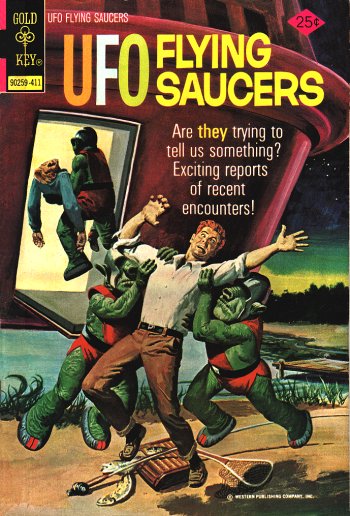
What were eyewitnesses really seeing? Will we ever know?
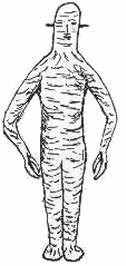

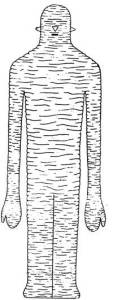
What did the eyewitnesses experience? Various artists have similar but different views.
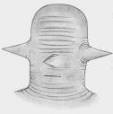
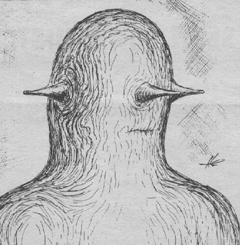
Harry Trumbore’s drawing is generally regarded as bringing together many of the elements of the eyewitness descriptions and other artists’ interpretations. Trumbore’s image below was first carried in Patrick Huyghe’s 1996 edition of The Field Guide to Extraterrestrials.
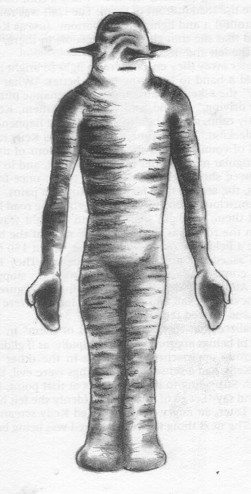
Then there are the 3-D figurines…
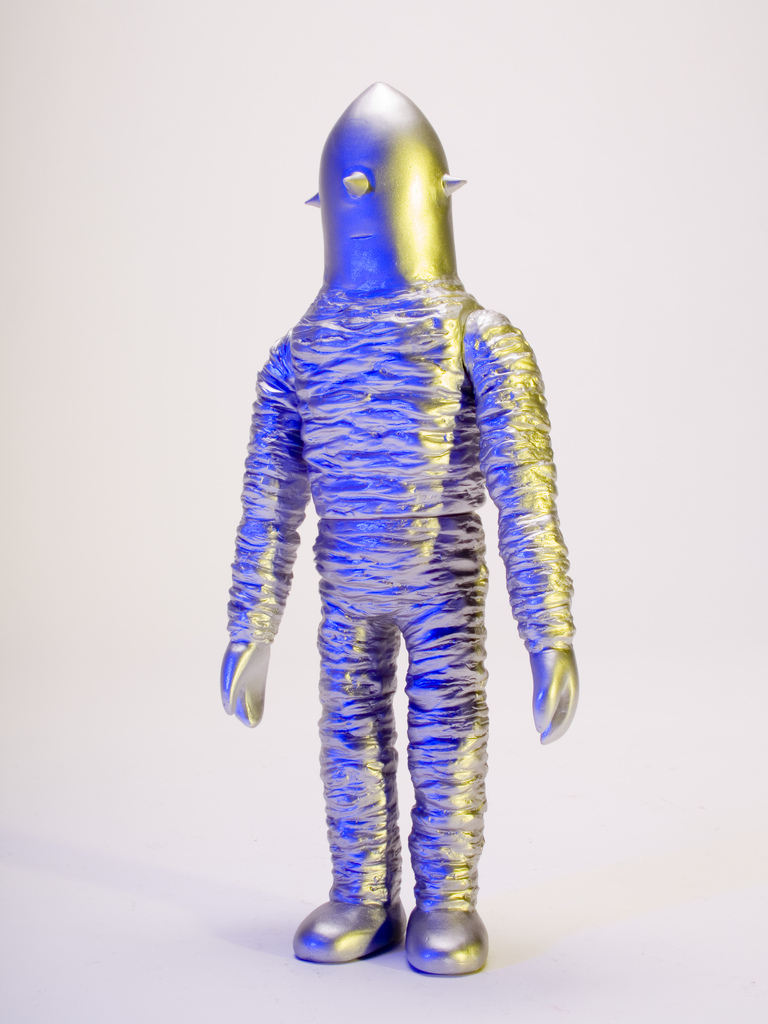

But something else is going on too.
In Patrick Huyghe’s The Field Guide to Extraterrestrials there is an investigative incident that needs to be reviewed and reflected upon. Richard J. Boylan, Ph. D. is a behavioral scientist, anthropologist, and certified clinical hypnotherapist. He has been involved in hypnotizing ufo abductees. What he found is worth pondering.
On page 131, Huyghe writes of how an eyewitness under hypnosis told “Richard Boylan that she had encountered a ‘spaceman.’ When he invited her to look closely at the face of the ‘human’ spaceman, she replied, ‘Oh my! It’s not human after all. It’s one of those Grays.’ But when he suggested that she look closely at the face of the Gray, she realized that the Gray was actually a reptoid.”
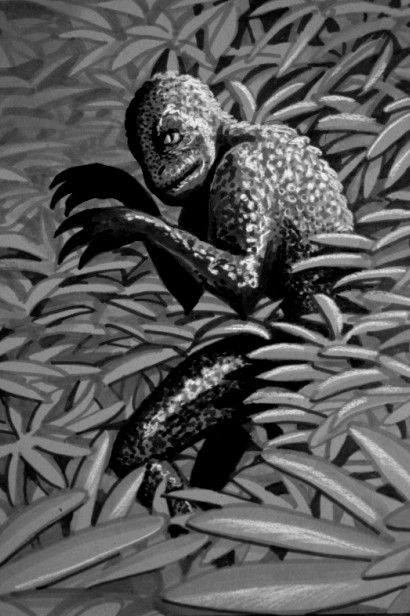
Wetzel’s “It” by Bill Rebsamen from Mysterious America (page 273).
Now, I am not here to talk about reptilians or aliens or ufonauts. My concern is with eyewitnesses. What are they seeing, and when they see Bigfoot, are they so scared or in shock or in trance that they are telling us what we want to hear? Or what culturally they “think” a Bigfoot looks like?
What would occur if Sasquatch encounters were examined more deeply by hypnotizing the eyewitnesses?
What happened to the use of hypnosis in earlier Bigfoot investigations?
Should we even broach this critical forensic difference between ufological and cryptozoological eyewitness stories? Within murder investigations, criminal reconstructions, and, yes, ufological and abduction research, the frequent use of the technique of hypnosis appears to have become divorced from the examination of Bigfoot eyewitnesses.
Why?
We aren’t sure why this occurred.
Indeed, considering that even in homicidal and violent crime cases where court admissibility of evidence obtained through this method is not regarded too highly, it is in the data gathering phrase of the investigation where there is great reliance on hypnosis to collect the details of the cases.
http://www.youtube.com/watch?v=mvx5fgd5F04
Bigfoot researchers, in the 1970s, experimented with hypnosis, but not in any well-crafted fashion.
Looking back at the first blush of the post-Patterson-Gimlin years of Bigfoot investigations, attempts at hypnosis seem to have been utilized. Was it successful? Was it incorrectly used? Did the gathering of details of the sightings fall short?
Are investigators today using hypnosis secretly, without most of the general public realizing this is occurring?
Is it time to reopen the debate about using hypnosis to mine deeper details about the human-Bigfoot encounters?
About Loren Coleman
Loren Coleman is one of the world’s leading cryptozoologists, some say “the” leading living cryptozoologist. Certainly, he is acknowledged as the current living American researcher and writer who has most popularized cryptozoology in the late 20th and early 21st centuries.
Starting his fieldwork and investigations in 1960, after traveling and trekking extensively in pursuit of cryptozoological mysteries, Coleman began writing to share his experiences in 1969. An honorary member of Ivan T. Sanderson’s Society for the Investigation of the Unexplained in the 1970s, Coleman has been bestowed with similar honorary memberships of the North Idaho College Cryptozoology Club in 1983, and in subsequent years, that of the British Columbia Scientific Cryptozoology Club, CryptoSafari International, and other international organizations. He was also a Life Member and Benefactor of the International Society of Cryptozoology (now-defunct).
Loren Coleman’s daily blog, as a member of the Cryptomundo Team, served as an ongoing avenue of communication for the ever-growing body of cryptozoo news from 2005 through 2013. He returned as an infrequent contributor beginning Halloween week of 2015.
Coleman is the founder in 2003, and current director of the International Cryptozoology Museum in Portland, Maine.










Excellent article, Loren!
I’ve often wondered why this wasn’t being used as a tool in the investigation of Bigfoot sightings. I know there are many cautions to be observed when using hypnosis in this manner, and I believe I’ve read that there may be a chance the subject may try to answer in a way they perceive will please the questioner, even under hypnosis. However, it seems this could be another useful tool to add to those already used in Bigfoot investigation. And using it as soon after the sighting as possible, then again at a later time, could provide an interesting comparison of remembered details.
The cultural ‘appropriation’ of cryptids is fascinating. How artists shape the look of these creatures according to their aesthetic sensibilities, and in turn how it molds our expectations with regards as how these creatures should look like.
You should have a word or two with Jeffrey Kripal, Loren. 🙂
The question would be how is the hypnosis/regression going to be done? With the big hullaballoo in UFO abductee interrogation of the last few years concerning Jacobs and Hopkins it would seem that one would want to have a real medical doctor conduct the regression. Otherwise, your just handing ammo to professional debunkers. There needs to be some sort of scientific method or oversight applied in the use of regression. That was done in the 70s with Bigfoot and from the 60s to 80s with UFOs; however, in the 80s amateurs started taking over the regressions in the UFO field leading to all sorts of monkey business. I can see where it might help with certain things but it has the potential to be a big can of worms. So I would say it would for the most part be a waste of Time.
East Texan I believe the reason it dropped off with Bigfoot was because the professionals conducting the regressions are basically getting the same descriptions all the time with little deviation so it becomes a cost benefit ratio question.
I don’t think the use of hypnosis to investigate Bigfoot eye witness accounts would be useful, and it would hurt the credibility of the field in the long run. Hypnosis places the subject in a highly suggestible state in which they are very susceptible to subtle, even unintentional, leading questions by the hypnotist, not to mention the unpredictable vagaries of the subject’s own imagination. What might be an interesting notion or mental image to ponder in the normal conscious state could become entrenched as a clear, factual memory, effectively creating a highly misleading false memory. The use of hypnotism in UFO studies is widely criticized for just this reason. Many believe that eye witness accounts of alien abductions are actually crafted, not recalled, during a series of suggestions made during the hypnotic sessions. Why would this be any different when investigating a Sasquatch sighting? In a field that requires more hard, accurate, irrefutable evidence to move forward, this would be a step backwards towards the unprovable and subjective.
What would happen if Bigfoot witnesses were submitted to hypnosis? I think it depends on the quality of the hypnotherapist being employed; and even more importantly, the level of neutrality of the hypnotherapist with regards to the nature of the case being investigated.
I remember reading in one of Vallee’s books how he speculated that aside the usual objections being given to the employment of hypnosis that could contaminate the memories of the witness through the use of leading questions, that there was also another possibility that would lead to contamination: the non-verbal transfer of the expectations of the enquirer into the mind of the hypnotized subject –in other words, telepathy.
What would happen if the therapist is someone convinced all Bigfoot sightings are hoaxes? Would the witness ‘remember’ through the hypnosis that the hairy creature it saw was actually a man in a gorilla suit? Would the witness even remember seeing the zipper line in the Bigfoot’s back?
So, I really don’t know if hypnosis would be a valuable tool to gain more data in Cryptozoology.
But there’s another thing: Do Cryptozoologists bother to re-visit witnesses after 10, 20 or 30 years, to find out how much the sighting of an alleged unknown creature has influenced in the lives of the witness? I think the only ones who have been interviewed so extensively have been Albert Ostman and Robert Gimlin, and the focus of those interviews have only been to test the deviation in the original accounts through the pass of time.
Well I would like to say as far as Hypnosis to think a Medical Hypnotist would be better then any other is a joke. That is like saying a Minister knows more about God then a person that had a near death experience and had a experience with It.
The Difference between them is one just read about it while the other experienced It. First of all Medical Doctors will not admit to either aliens or Bigfoot. I was doing past life regression when I was young. It was not even really excepted as a real thing. Kreskin made it famous in the early 60’s. I started right after metting with him. I called it past life regression around 1969. Past lives were also not excepted as real, even then.
I had my first experience with a alien when I was 12. I had my first Sasquatch experience when I was 48. My good friend was working with them for over 40 years. So they are as real as anything else to me but they are different.
Absolutely the best article written in years and may I say, would deserve a book with all the information that can be conveyed, it’s mind boggling. Moving beyond that, how about the cave paintings depicting Giants or supernatural beings? What’s the psychology of a caveman, to use a colloquial term, did they exaggerate what they drew? Were their minds able to do that? Where does that leave us? Please more Loren.
Now I believe we are veering a weetad into woo-woo.
People are seeing an animal. They saw it cold sober and are describing it, very consistently, in cold sober terms.
It’s bad enough that this topic has been conflated with the paranormal. Let’s not make it worse.
I agree with DWA – cryptozoology has made great progress towards being recognized as a legitimate discipline by the mainstream world and dabbling in hypnotherapy or pushing the study of unknown animals towards the paranormal only diminishes the gains that have been made.
Yes to everyone else that said this–there’s been plenty of flap in recent years about the validity of hypnosis as a tool at all because of the subjectivity involved. It’s raised a lot of questions about that vulnerable and suggestive state and the ability to mess with it.
If you want to break it down, pretty much anything and everything has a subjective side to it. Artists who draw recreations may well stick to the details given, but they are also biased by their own perceptions to a degree (and I’m giving fair balance to those who try their best to keep their own perceptions in check).
With BF, people are seeing something and it’s an animate creature walking bipedally (most of the time) and so on. I’ve read too many accounts on the BFRO site recently where people found the site and wrote in. Some were questioned after the account to bring out more details, but the similarities between so many people without individual interactions leads me to believe there’s a creature out there.
My own personal perception of hypnosis is akin to going back to leeching as a means of healing instead of current medical practices. Hypnosis certainly has no more respect among the general public (not to mention the scientific community–not that I’m all that concerned or worried about the opinion of the scientific community these days) than present methods of investigating BF and introducing it into the “investigative repertoire”, to me, is only adding more hokem.
Yeah. Let’s keep it clean and by the book. Investigate, get as many details as you can and move on to the next account until we can pin down enough information to anticipate and give our investigations an edge in the field so that we can get the “proof” we need to set this to rest.